How easy and simple to prepare pickles for the winter without vinegar
Salting cucumbers without adding vinegar keeps their freshness and richness of taste. Thanks to the peculiarities of canning by this method, the product remains crispy and juicy, and the simplicity and ease of recipes for such salting will appeal to even the busiest housewife.
How to cook salted cucumbers for the winter without vinegar - we will tell you in detail below.
The content of the article
Features of pickling cucumbers without adding vinegar
The main feature of canning this vegetable without adding vinegar is the high requirements for ingredients: they must be of high quality and fresh.
It is important to choose the variety of cucumberssuitable for long storage, since not all varieties can be used for conservation. An equally important point is the thorough preparation of all components and containers for salting.
The absence of acetic acid makes the taste of cucumbers softer and richer. This method of salting is suitable for people who adhere to the principles of proper nutrition, and those who follow the figure and try to lose weight.
Important! It is undesirable to store blanks for several years. It is best to consume pickled cucumbers in one winter, right after cooking.
The classic way of salting in jars
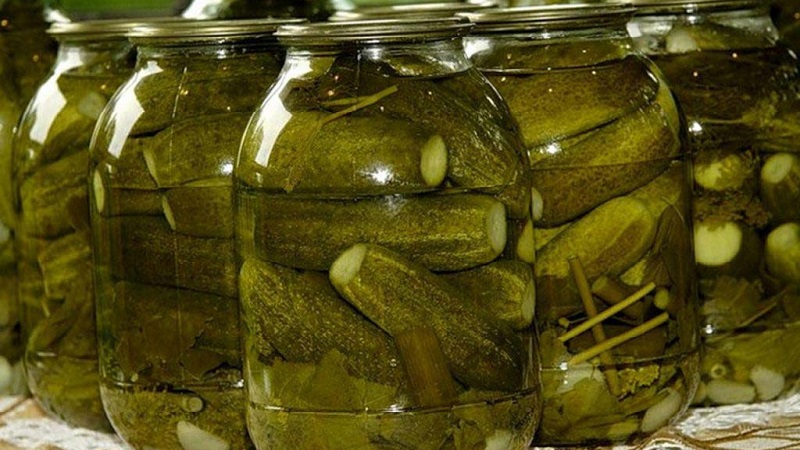
The classic method of canning a green vegetable consists of several stages: selection and preparation of ingredients and containers, placing food in a jar, preparing the brine and rolling. Unlike the cold method, the classic hot method involves steeping the product in the marinade for five days.
Important! It is recommended to store the salting in a cool, dark place away from direct sunlight.
Preparation of cucumbers, spices, containers
The best option for preservation is medium-sized cucumbers with large pimples. The vegetable must be firm crispy and fresh, its color is a rich dark green.
Light color indicates that the product was grown in a greenhouse, has a bitter taste or overripe.
The most popular varieties and hybrids for pickling:
- Nezhinsky;
- Zozulya;
- Fontanelle;
- Vodogray.
The choice of spices depends on individual taste preferences. Most often used:
- black peppercorns;
- oak, currant, cherry leaves;
- parsley;
- dill;
- garlic;
- Bay leaf.
Greens, like the cucumbers themselves, are thoroughly washed under running warm water without using detergents, then dried. The garlic is peeled and cut into slices, and the herbs are sorted into small twigs.
A regular glass jar of any size is suitable as a container for canning. The container is examined to make sure there are no chips, cracks or breaks.
The container is washed with soda, after which it is sterilized:
- With steam. The method is suitable for large cans. A pot of water is placed on the fire. When the water starts to boil and steam begins to evolve, a grate is fixed over a pot of boiling water and the jar is placed upside down on it so that the steam splashes over the walls of the glassware. After 10-15 minutes, there should be no water drops on the inner walls of the container. The absence of drops is considered a sign of proper container sterilization.
- With hot water. Suitable for small cans. Put the glass jar in a saucepan, fill it completely with water and turn on the fire. 10 minutes after boiling, the fire is turned off, and the salting container is cooled.
The container for preservation can also be sterilized using a microwave oven, pouring water into it and turning on the microwave for 3 minutes, with a power of 800-900 W.
Important! After sterilization, the jar is placed on a clean ironed towel.
Styling
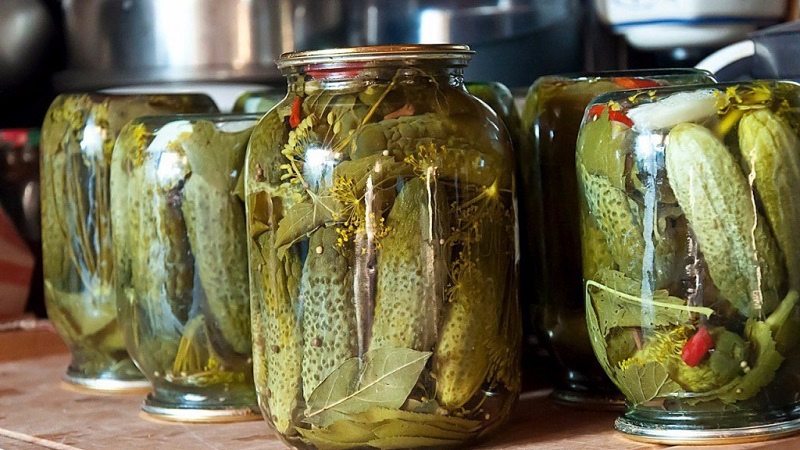
Place the ingredients in the prepared container one by one:
- first, lay leaves, herbs and seasoning on the bottom of the jar in layers;
- then put the cucumbers - usually the bottom layer of the cucumbers is placed vertically, and the top horizontally.
If you plan to use vegetables of different sizes for pickling, put the smaller cucumbers closer to the lid, and place the large fruits lower.
Brine preparation
The brine is prepared using water and salt. To give the taste "zest" and a spicy aroma, add greens - for example, a cherry leaf.
The first way
Brine preparation:
- Dissolve 100 g of salt in 1 liter of hot water.
- The cucumbers are poured to the very top with the resulting salted liquid and covered with a soft lid.
- Let it brew for 4-5 days, until the brine is transparent.
After the brine becomes transparent, it is drained and filled with a new portion of water.
Second way
Brine preparation:
- Pour the prepared container with all the ingredients with clean boiling water. Wait for cooling.
- Pour the water from the jar into the pan, add sugar, salt and your favorite spices, seasonings and herbs. Boil.
- The resulting solution is again poured into a jar of cucumbers and rolled up.
You can change the brine until the sediment is completely washed out from the bottom of the can, in 3-4 doses, but this is not necessary.
Sunset
It is important to sterilize the lids before seaming. This can be done using the steam method, holding them over steam or boiling them in boiling water.
Reference. A soft nylon or tin cover is selected for seaming.
Other recipes without vinegar
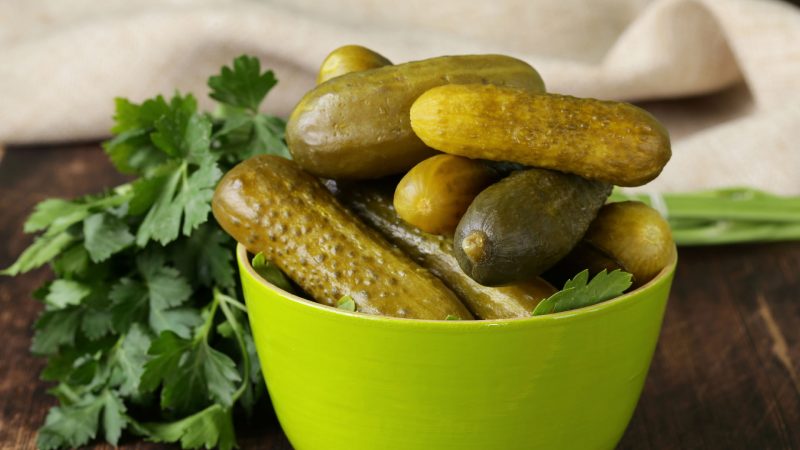
Canning cucumbers without acetic acid diversifies the addition of various seasonings, spices and vegetables that give the dish an original taste.
Aceless-free salting can be carried out not only with the classical, but also with the cold method, which will save time.
Cold cucumbers with horseradish and garlic
For cold salting, use ordinary tap or filtered water.
Ingredients:
- clean water at room temperature - 1.5 liters;
- medium-sized cucumbers - 1 kg;
- horseradish - 1 root and 1 leaf;
- garlic - 2-3 cloves;
- salt - 100 g.
Preparation:
- All components are washed, the garlic is peeled, but not chopped.
- Dissolve the salt in water.
- Greens and garlic are placed on the bottom of a pre-prepared jar. Add black peppercorns or bay leaves to taste.
- Cucumbers are densely spread over seasonings and herbs.
- All components are poured with salt water and removed for a couple of days in a dark place to infuse. The jar is covered with a soft lid.
- After 2-4 days, the brine is drained, and the contents of the container are washed out of fermentation residues.
- Pour clean water into a jar and roll it up with a dry sterilized lid.
Place small clean cotton rags or small kitchen towels under the pickle jars. If the lid comes off during storage, the brine will not stain the shelf.
With the addition of mustard
The addition of mustard will add a piquant taste to the appetizer; it will harmonize well with almost any hot dish.
Required products:
- clean water - 1.5 l;
- fresh cucumbers - 1.5 kg;
- mustard powder - 20 g;
- greens to taste - dill, parsley, bay leaf;
- garlic - 2 cloves;
- salt - 60 g.
Preparation:
- The green vegetable is soaked in water for 2-3 hours. Then the fruits are washed under warm running water and both ends are cut off, on both sides.
- Sterilize the container and lid.
- Spread greens and garlic on the bottom. Cucumbers are then sent to the jar.
- Pour boiling water over everything and cover with a lid.
- After 10-15 minutes, the water is poured into a saucepan. Mustard and salt are added to this water. Put on fire and wait for a boil.
- The resulting brine is poured into a container, rolled up, cooled and stored in a cool, dark place.
Cool small jars of hot marinade, preferably upside down, placing the bottle on the lid.
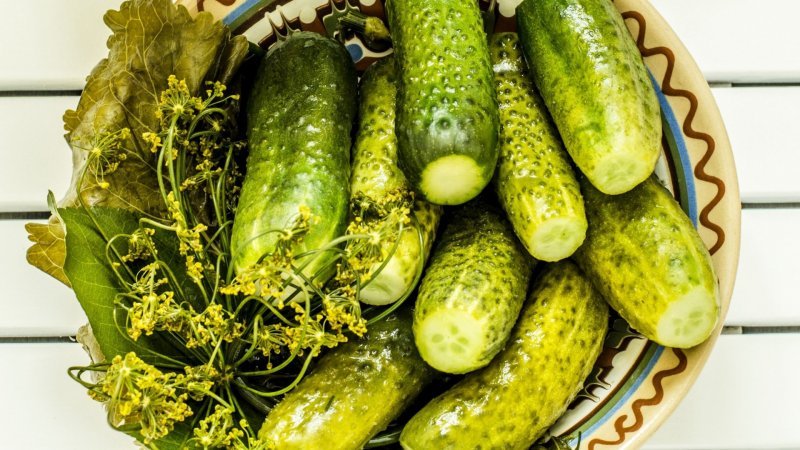
Cucumbers "under the degree" with vodka
When preparing blanks with vodka, not only spices, herbs and salt are added, but also a little sugar.
Ingredients:
- clean water - 1 liter;
- fresh cucumbers - 1 kg;
- vodka - 50 ml;
- horseradish - a couple of leaves;
- dill - 2 umbrellas;
- garlic - 4-5 cloves;
- salt - 90 g;
- sugar - 60 g.
Preparation:
- The vegetables are washed and the tips are trimmed.
- Fill the container first with herbs and spices, then cucumbers.
- Boil water, add sugar and salt. Cool down.
- Pour the resulting marinade into a jar, then pour vodka into the same.
- Close the container with a soft lid.
Soft nylon covers, unlike tin ones, tend to grow and slightly expand when heated. Therefore, they are more convenient to use with the hot canning method.
In tomato juice
Pickled cucumber in tomato juice will be an original alternative to the usual lecho.
Required products:
- fresh cucumbers - 500 g;
- tomato juice - 500 g;
- fine salt - 1 tbsp l .;
- sugar - 3 tbsp. l .;
- garlic - a couple of cloves;
- cherry, currant or oak leaves - optional.
How they cook:
- Pour the pre-washed fruits with cool water for 2-3 hours. Cut off the ends from each vegetable.
- Spread on the bottom of the container 1/3 of all the spices and leaves used for flavor.
- Then put a layer of cucumbers, and on top of them - the remnants of seasonings.
- The jar is filled with hot water, pouring in water gradually so that the glass does not burst.
- Add salt and sugar to tomato juice, mix.
- Drain the water from the container, boil and pour it back into the container.
- Add tomato juice and roll up.
Lovers of a sour taste add an aspirin tablet to the water.
Cucumbers with red currants
The version with red currants has a bright, rich taste with a soft, pleasant sourness. Instead of currants, gooseberries are also used.
Ingredients:
- water - 1.5 l;
- cucumbers - 1.5 kg;
- red currant brushes - 100 g;
- optional additions - dill, garlic, horseradish;
- sugar - 150 g;
- salt - 120 g.
Cooking method:
- Wash vegetables and currants. Cleans the fruit from the tails.
- Horseradish, dill and a couple of cloves of garlic, cut in half, are placed on the bottom of a glass container.
- Add cucumbers and currants.
- Pour boiling water over everything for half an hour.
- Pour water into a saucepan, boil it again and pour it into a container.
- The water is drained from the container again. Add sugar and salt to the resulting brine, mix, boil and pour into a jar. Roll up the lid.
Tips & Tricks
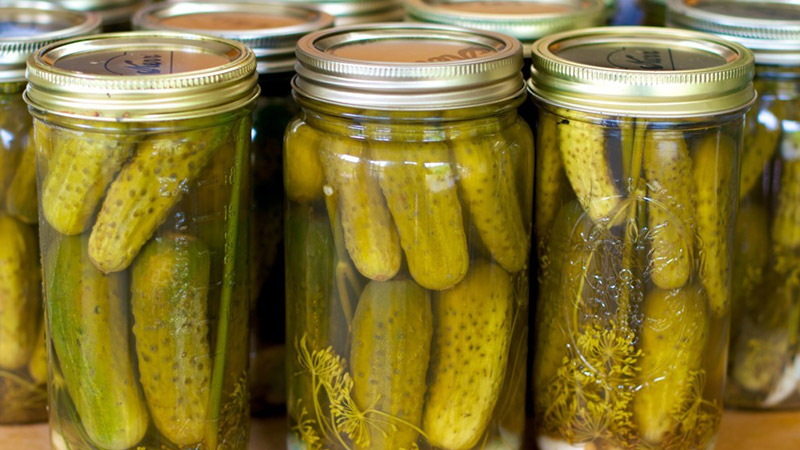
Some subtleties and recommendations for cooking salting:
- the fresher the cucumber, the tastier the salting will turn out;
- oak leaves and peppercorns will not only add flavor, but also keep the fruits crispy;
- brine is best prepared from rock table salt;
- you can diversify preservation by adding bell pepper, tomatoes, onions.
The resulting appetizer can be added to pickle soups, used as an addition to a meat or vegetable dish.
Conclusion
There are several ways to preserve a vegetable for the winter without using vinegar: classic hot, cold, with the addition of mustard, currant, tomato juice or vodka. Each of them has its own characteristics - choose the one that you like. A variety of daily and festive dishes for you!